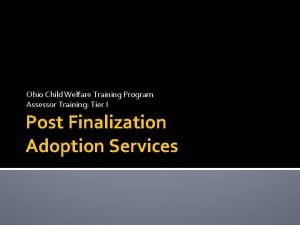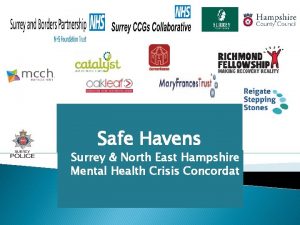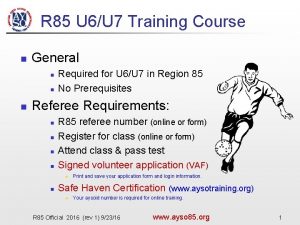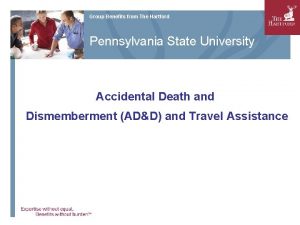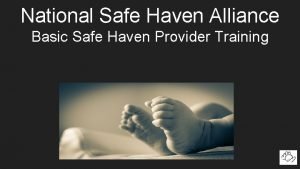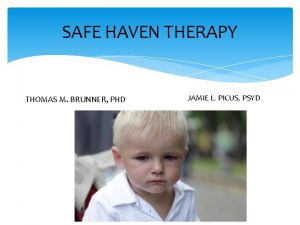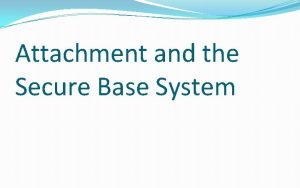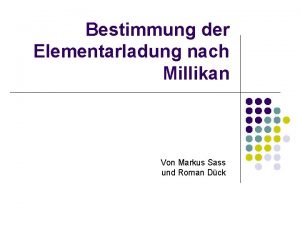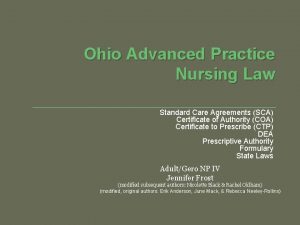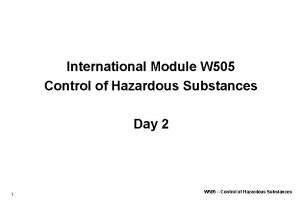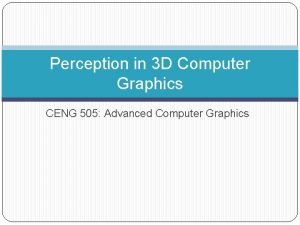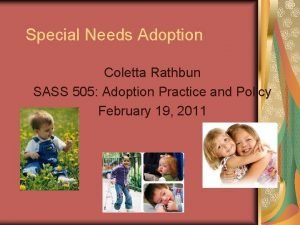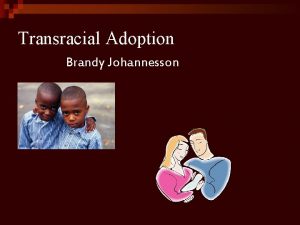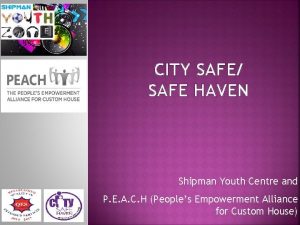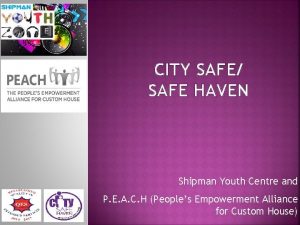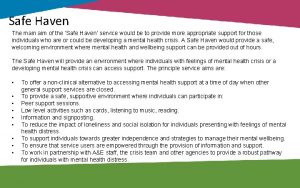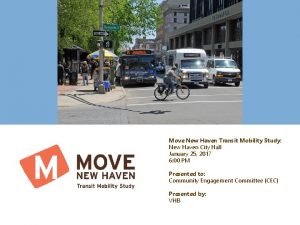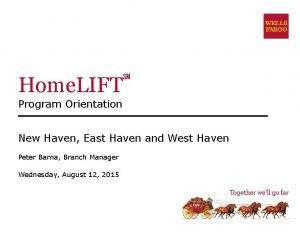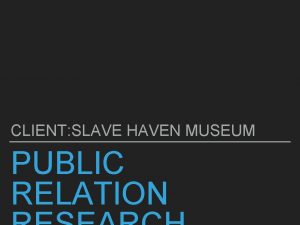Safe Haven Laws in Ohio SASS 505 Adoption





















- Slides: 21

Safe Haven Laws in Ohio SASS 505 Adoption: Practice and Policy Wendy Arnold February 25, 2012

Safe Haven Laws in Ohio • A parent can legally leave a baby in a safe haven • The baby is no more than 30 days old • The baby does not appear to have been physically abused or neglected http: //www. safehaven. tv/states/ohio/

Safe Haven Laws in Ohio • The parent will not face criminal prosecution if the baby is left at a designated “Safe Haven” • In Ohio a safe haven is a hospital, police or fire station • Baby is examined at a hospital and placed in care through CPS for eventual adoption http: //www. safehaven. tv/states/ohio/

Passing of the Safe Haven Laws • The Ohio State Legislature passed safe haven laws in April 2001 • 49 states and Puerto Rico have enacted safe haven legislation • 54 babies were relinquished to safe havens in Ohio between 2001 and 2007 http: //jfs. ohio. gov/safehavens/

Safe Haven Data in United States • Thousands of infants are “abandoned” (or are unlikely to leave the hospital in the custody of their parents) • The number has increased by more than 40 percent in 7 years, from 21, 600 in 1991 to 30, 800 in 1998 • There were 105 unsafely deserted infants in 1997 Department of Health and Human Services

Safe Haven Data in United States • 265 children murdered under the age of one in 2000 • 8% of deaths occur on the day of baby’s birth • 139 neonaticides were recorded between 1983 -1991 • 65 cases of “discarded” babies, 8 deceased in 1992 • 105 cases of “discarded” babies, 33 deceased in 1997 Department of Health and Human Services

Safe Haven Data in United States • • • Total Births 3, 880, 894 Births to Unmarried Women 1, 257, 444 Births to 16 -24 Year Olds 1, 398, 928 Infants Safely Abandoned in Hospitals 30, 800 Infanticide of Children Less than 1 Year Old 278 Department of Health and Human Services

Who Uses Safe Haven Laws? • Statistics are usually co-mingled between neonaticide and safe haven babies so it’s difficult to identify a norm specifically for mothers of safe haven babies • Crisis hotline statistics indicate mothers of safe haven babies are usually teens and single women in their 20 s 30 s • Some research indicates mothers of safe haven babies are young, single women who have limited finances and conceal their pregnancy http: //www. nationalsafehavenalliance. org/

Who Uses Safe Haven Laws? • Infant is usually mother’s first child and father usually is not aware of the pregnancy or if he is aware he is uninvolved • Women are driven by confusion and panic, but not anger and they do not have a conscious desire to hurt the child • Neonaticide is rarely premeditated, but usually triggered by the same emotions that caused denial of the pregnancies http: //www. nationalsafehavenalliance. org/

Criteria for Parent Relinquishing Child • The child is voluntarily delivered to the Safe Haven by the parent and left in the physical possession of a Safe Haven employee • The child has not been abused or neglected • The parent does not express intent to return for the child • The parent will not be required to disclose any identifying information, but may voluntarily do so http: //www. childwelfare. gov/systemwide/lawspolicies/statutes/safehaven. cfm

Criteria for Parent Relinquishing Child • The parent will not be required to provide medical information regarding the child, but may voluntarily do so • The parent will be allowed to leave the safe haven at any time • The parent will not be pursued or followed www. childwelfare. gov/systemwide/lawspolicies/statutes/safehaven. cfm

Debate About Safe Haven • Sends a signal, especially to young people, that they do not have to assume responsibility for their actions and deserting children is acceptable • Some feel that the people who choose to leave their baby in harms way such as a dumpsters are not going to choose to use the safe haven laws instead • Some feel that the people who are most likely to use the safe haven laws are not aware of the laws due to minimal media attention http: //www. adoptioninstitute. org/whowe/Last%2520 report. pdf

Debate About Safe Haven • Encourages women to conceal pregnancies, discourages placement with relatives • Increases abandonment by women who otherwise would not have done so because it seems “easier” than counseling or making an adoption plan • It deprives biological fathers of their legal right to care for their baby even if they have the desire and personal resources to do so • Ensures that the children who are abandoned can never learn their genealogical or medical histories, even when the consequences for their health are dire http: //www. adoptioninstitute. org/whowe/Last%2520 report. pdf

Research/Empirical Evidence • They continue to oppose data collection requirements even now after the bills have passed, insisting that reliable data is unnecessary, • It allows their claims of ‘thousands of babies saved’ to go unsubstantiated • Data collected in the past did not distinguish between safe haven babies and those abandoned in unsafe places

Research/Empirical Evidence • All 50 states are currently required to collect statistics and track data on safe haven babies • No data or very little data was collected or required to be collected when safe haven laws were initially passed • Sadly those who have advocated enacting these laws DO NOT support accurate data collection • They have consistently and actively worked to have any amendment requiring data collection stripped from the final versions of the bills

Research /Empirical Evidence • Public officials conducted little research before the passing of safe haven laws • Federal and state governments did not systematically track number of infants abandoned in public places to determine the extent of the problem • Legislative policies quickly addressed the critical issue of abandonment but have not considered what causes women to desert their children • Little social science research specifically about mothers who unsafely abandon their babies

Research /Empirical Evidence • Relevant empirical information is available typically describing unmarried teens who deny their pregnancies and then give birth alone in non-hospital settings. • The most relevant social science research related to abandoning mothers is of women who commit neonaticide, including death resulting from abandonment. • A few recent studies analyze the patterns and causes of neonaticide related to ignored pregnancies and find some common characteristics among the affected women

Safe Haven Law

Public Broadcast Safe Haven Video This video is designed to enlighten mothers who might be considering the option of not parenting their newborn to consider safe haven laws. The issue is that some mothers might be uninformed of the safe haven laws. For those who are aware of the law it takes great courage to place your baby in a safe haven. The video shows the joy of the adoptive parents of the safe haven babies who are truly grateful to the mothers who legally abandoned their babies at a safe haven. Http: //www. nationalsafehavenalliance. org/

Safe Haven Websites • http: //adoption. about. com/library/weekly/aa 011700 a. htm • www. saveabandonedbabies. org • www. newbornlifeline. com • http: //www. legislature. state. oh. us/Bill. Text 127/127 SB 3041 y. pdf • http: //www/childwelfare. gov/systemwide/laws/policies/statutes/safehaven. cfm • http: //jfs. ohio. gov/safehavens/ • http: //www. adoptioninstitute. org/whoe/Last%2520 report. pdf • http: //www. nationalsafehavenalliance. org/

Research Articles • Ianelli, V. (2008). Safe haven laws for abandoned babies (Nov. 22, 2008)Pediatrics about. Nov. 22, 2008 6 -11. • Mueller, J. & Sherry, L. (2009). Abandoned babies and absent policies. Health Policy, vol. 93, issue 2 -3, 157 -164 • Sanger, C. (2006). Infant safe haven laws: Legislating in the culture of life Columbia Law Review, 106(4), 753 -759 • Safe Haven Video • Safe haven Poster
 Ohio child welfare training program
Ohio child welfare training program Safe haven guildford
Safe haven guildford Ayso safe haven training definition
Ayso safe haven training definition Hartford safe haven program
Hartford safe haven program National safe haven alliance
National safe haven alliance Ucl data safe haven
Ucl data safe haven Jamie picus
Jamie picus Safe haven vs secure base
Safe haven vs secure base Mina olin siin kokkuvõte
Mina olin siin kokkuvõte Larry sass mit
Larry sass mit Henno nurmsalu
Henno nurmsalu Sports 1 marketing
Sports 1 marketing Sass double ampersand
Sass double ampersand Sass stylus
Sass stylus Chapter 7 sports and entertainment marketing
Chapter 7 sports and entertainment marketing Millikan versuch auswertung
Millikan versuch auswertung Ohio nurse practitioner prescribing laws
Ohio nurse practitioner prescribing laws 505
505 Gloire a dieu que ce chant retentisse lyrics
Gloire a dieu que ce chant retentisse lyrics 505
505 34/72 simplified
34/72 simplified Nstm 505
Nstm 505
